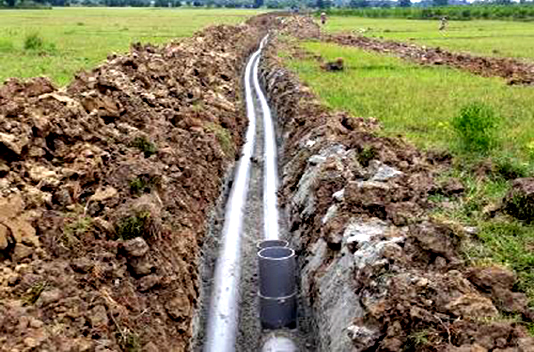By Dr Aynal Haque
RAJSHAHI, Nov 7, 2020 (BSS)- A new potential mode of efficient irrigation
has been revealed since implementing a project related to promotion of
subsurface irrigation systems for the first time in the Barind area.
Subsurface pipeline is being adjudged as the proven means of ensuring
irrigation efficiency as it can save at least 40 percent irrigation water.
Officials opined that the initiative will contribute a lot towards
lessening the gradually mounting pressure on the groundwater tables in this
vast dried area in the years to come. The system has also contributed to the
diversification process in the project covering areas.
Mazharul Islam, 48, of Daldali village under Volahat upazila, is now happy
over availing the scope of irrigating his farmland with subsurface piped
water for the last couple of years.
In the system, we need less water for irrigation as the extent of wastes is
less than the conventional open-drain irrigation system, he added.
“We’ve started enjoying the privileges of efficient irrigation,” said
Nibaran Das, 53, another farmer of Beliaghata village.
As part of efforts to make its irrigation system more efficient, Barind
Multipurpose Development Authority (BMDA) has implemented a project titled
‘Enhancement of Irrigation Efficiency through Construction of Sub-surface
Irrigation Channel’.
BMDA, the ever-largest irrigation providing state-owned entity in the
country’s northwest region, has implemented the Taka 136.16-crore project in
25 upazilas of Rajshahi, Naogaon and Chapainawabganj districts recently.
“We’ve installed 1,080 kilometres upvc pipelines and 216 kilometres
flexible pipes through saving agricultural lands under the four-year
project,” said Engineer Shahidur Rahman, director of the project, while
talking to BSS here on Friday.
More than 3,000 farmers were imparted training on how to properly handle
and maintain the constructed infrastructures so that they can derive total
benefits of the project.
Engineer Rahman said the installed pipelines have expanded irrigation area
to around 32,400 hectares of land contributing a lot towards cropping yield
around 1.62 lakh tonnes on an average per year.
As a whole, the water saving initiative is being seen as potential
generating hopes of lessening the gradually mounting pressure on underground
water.
Highlighting aspects of the initiative Jahangir Alam Khan, Coordinator of
Integrated Water Resource Management (IWRM) Project, said efficiency in
irrigation has become a necessity for reducing the misuse of water alongside
decreasing agriculture production cost.
He opined that the conventional irrigation method has the problem of
misusing water triggering pressure on both ground and surface water posing a
threat to ecology. So, some major parameters like water distribution system,
irrigation scheme management system, water marketing system, sources of
water, source of energy, Alternate Wetting Drying (AWD) and types of pumps
should be brought under consideration.
Khan mentioned that the agriculture sector has started facing the problem
of irrigation water scarcity which is being adjudged as an obstacle to crop
production.
The sector has also to face huge production costs due to various reasons
pushing farmers into a difficult situation. So, time has come for more
promotion of underground canal to improve irrigation efficiency, he added.
With initiative of the IWRM project, more than 12.58 lakh community people
of 2.66 lakh households are being motivated and encouraged towards using
surface water for irrigation purposes besides farming various less-irrigation
consuming crops to reduce the pressure on the underground water.
The project is being implemented by DASCOH Foundation around 1,280 drought-
hit villages in 39 Union Parishads (Ups) and three municipalities of eight
upazilas in Rajshahi, Naogaon and Chapainawabganj districts since 2015, said
Jahangir Khan.



